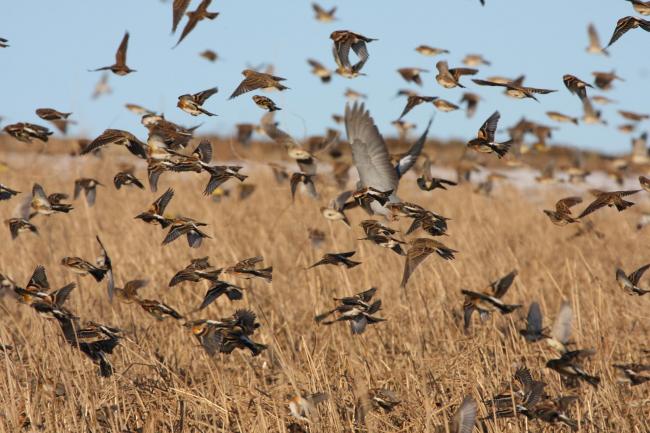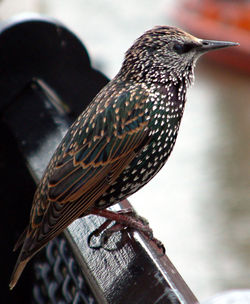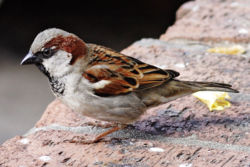Wild bird control
Wild Bird Control
Wild birds can be a considerable nuisance and even a threat to commercial poultry farms. They can create a mess with their droppings, consume and contaminate feed and water, and damage insulation. More seriously, they can act as vectors (carriers) for a wide range of diseases and parasites that can infect commercial poultry. Clearly, wild birds are undesirable in or around poultry houses. However, before beginning any effort to control wild birds, it is important to understand effective approaches and the legal limitations.
The best way to prevent harm to the stock from wild birds is to keep wild birds out of the sheds and to minimise their presence on the farm around the commercial poultry flocks.
Controlling wild birds on the farm

Wild birds
Depending on the size of the farm and its geography it may not be necessary, or even desirable, to attempt to eliminate wild birds from the farm entirely. The main aim is to minimise the presence of wild birds in close proximity to poultry houses or the paddocks in which commercial poultry range. This will minimise the risk of wild birds coming into direct contact with commercial poultry or disease agents from wild birds being transferred to the poultry by staff or equipment.
A suitable security fence will keep some wild birds out of the farm, however this will be ineffective against many wild bird species. The main approach to minimising wild birds on the farm is to ensure that the areas around commercial poultry flocks are not attractive to wild birds. This involves ensuring that feed and water are not accessible to wild birds and minimising shelter for roosting and nesting. These approaches can be problematic for free range farms where it is necessary to allow commercial poultry on the range to have free access to feed and water and where shade vegetation may be desirable for the benefit of the commercial flock. Wild birds can be minimised on free range farms by ensuring that feed and water is only provided within the poultry house, by providing artificial shade and by ensuring that ranges are well drained and any standing water sources that may be contaminated by wild birds are fenced off from commercial poultry. The use of roosting spots on sheds should be discouraged by the use of netting, repellents, or “porcupine wires”. Conditions that promote multiplication of insect populations should be avoided as well, as trees that bear fruit attractive to wild birds.
In some cases it may be possible to take more active control measures such as shooting, trapping, baiting or destroying nests. However, there will be legal constraints on these measures for many wild bird species and poultry producers must ensure they are operating within the law before using any of these methods.
Although effective poisons for nuisance bird species exist, most of these are restricted use materials and can be toxic to humans. In addition, it is important to remember that use of these poisons means you are liable for the death of any birds consuming the poisons, whether they were the intended target or not. Therefore, it is very important to use poisons prudently and according to label directions.
There are numerous traps and trap designs available from a variety of sources. Most designs are live traps, which allow the user to free everything other than house sparrows, pigeons and starlings. When using traps, it is important to feed birds with the bait for a few days (prebait) prior to starting and to check traps often.

Starling
Shooting is not an effective means of destroying a large number of birds. Yet shooting can be an effective method of eliminating a few individual house sparrows, pigeons or starlings within a relatively small area. However, choosing the right weapon and location for shooting is obviously important.
Nest destruction can be an extremely effective method of reducing wild bird numbers. However, nests are often constructed in locations that are high above the ground to avoid predators, so nest destruction efforts can become very involved. In addition, nest destruction should be approached with caution since nest materials often contain many thousands of insects (especially mites) and possibly disease causing bacteria or viruses. It is important to avoid spreading these vermin and microbes to you or your flock. It is also important to quickly destroy nesting materials following removal to prevent reuse of the materials by other birds.
While it is illegal to harm or capture protected bird species, it is not illegal to frighten them. Devices are available for frightening wild birds, such as bird distress calls, pyrotechnics, flashing lights, whirling shiny items, balloons, hawk or owl figures and a variety of other methods that can effectively reduce bird concentrations in a given area. However, it is important not to get into a routine; successful operations depend on timing, persistence, organisation and diversity in the devices used.
Controlling wild birds in poultry sheds

Shed walls, roofs, floors and doors should be kept in good repair to prevent gaps that would allow entry of wild birds into the shed. Wire netting in good repair should be placed over any ventilation openings. All holes must be repaired as soon as possible and before they get too big.
All doors should be kept closed at all times when not being used.
The use of poisons or traps may be permitted for certain wild bird species and may be a viable option within poultry houses. However, when using poisons it is important to ensure that they are suitable for use in poultry houses and are used in accordance with manufacturer’s specifications.

